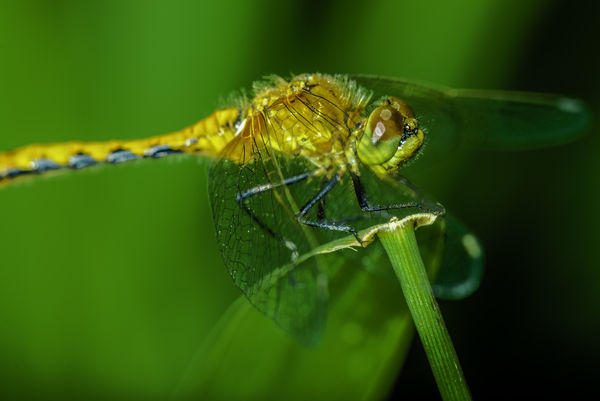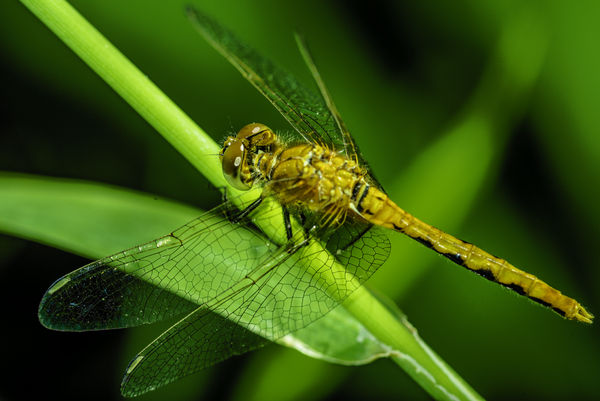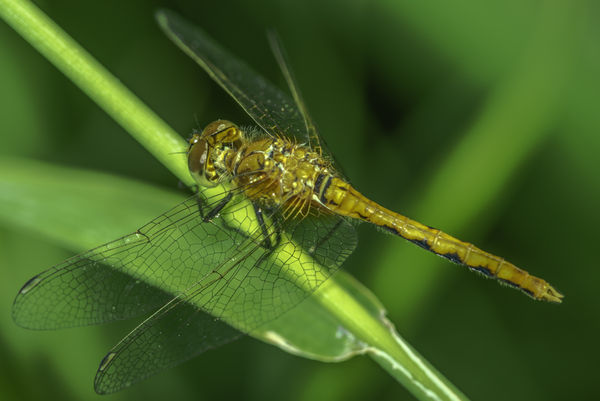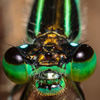DOF so shallow
Jul 12, 2014 20:26:32 #
I am still trying to learn how to compose with such a shallow DOF. I know what I am trying to accomplish but the subjects don't seem to grasp what it is I'm trying to do.
I did not have my flash with softbox on with me when I sighted this dragon. I did have my three R200s with the diffusers with me but this unit seems to create separate light sources which looks unnatural, at least to me.
I did not have my flash with softbox on with me when I sighted this dragon. I did have my three R200s with the diffusers with me but this unit seems to create separate light sources which looks unnatural, at least to me.
Jul 12, 2014 23:55:37 #
Overall illumination looks good Matthew. Seeing the triple hotspot in the eye is odd looking. You note the SB-R200s are diffused but the intensity of the hotspots suggests that the diffusion isn't adequate. It's hard to get good diffused light on small flash heads. If you want to eliminate this, a diffused soft box is best for reflective subjects. Small flash heads with minimal diffusion are best suited for matte subjects.
Your photos appear to have a green cast. Did you increase saturation in post?
If you want greater DoF tighten down the aperture to f16.
I continue to be impressed with the resolution the D800e captures with a heavy crop. Was the crop done in camera or post?
Your photos appear to have a green cast. Did you increase saturation in post?
If you want greater DoF tighten down the aperture to f16.
I continue to be impressed with the resolution the D800e captures with a heavy crop. Was the crop done in camera or post?
Jul 13, 2014 08:02:12 #
A-PeeR wrote:
I don't think the areas that we're seeing in the dragonfly's eyes are really hot spots. I've noticed this on occasion with facial closeups in some dragonfly photos that I've taken. It looks as if those are damaged parts of the ommatidia themselves. I'm wondering - in the wild flying around that these insects do - if they don't accidentally hit the eyes against something and abrade a section of that compound eye. When you enlarge that spot, you can still see the outline of each ommatidium clearly. If it was a hotspot, it would be burned out.Overall illumination looks good Matthew. Seeing the triple hotspot in the eye is odd looking. You note the SB-R200's are diffused but the intensity of the hotspots suggests that the diffusion isn't adequate. It's hard to get good diffused light on small flash heads. If you want to eliminate this, a diffused soft box is best for reflective subjects. Small flash heads with minimal diffusion are best suited for matte subjects.
I did a quick search and ran across this page - suggesting the same idea: http://nwdragonflier.blogspot.com/2013/09/id-challenge-5-answer.html
Jul 13, 2014 13:05:12 #
A-Peer, I did increase the saturation in the first two but third shot has no work done on it. I think the green cast is from sitting down in the grass that is over 4-5' tall so all the natural light is being diffused through all the grass. Macro is a newer hobby for me, and I tend to not be prepared sometimes that the subjects present themselves. I am continually impressed by the standard of shots many of the posters here produce. While I do love my camera, I feel if my wife had not bought it for me, for Christmas, I am too cheap to have purchased it myself.
Jul 13, 2014 13:13:37 #
Oknoder wrote:
Damn! Your wife purchased a Nikon D800e as a gift for you? She is a keeper!While I do love my camera, I feel if my wife had not bought it for me, for Christmas, I am too cheap to have purchased it myself.
Jul 13, 2014 13:16:08 #
Oknoder wrote:
I tend to agree with A-Peer that these are hotspots-- at least that what it looks like from the downloads. If you have neutral diffusion on your flash (realize none was used here), you will neutralize some of the color cast picked up from the ambient light. Getting square to the subject is the ideal to maximize DOF--but of course critters don't always cooperate. I have found that dragonflies will return to the same perch, I sometimes just sit for 15-20 minutes. I think the green cast is from sitting down in the grass that is over 4-5' tall so all the natural light is being diffused through all the grass.
I have the SB200s but have gone away from them because of the small light source-- the snap-on diffusers have never satisfied me. I've played with making my own, but haven't been pleased with the results. Sometimes it's just better to put in the practice--that's more fun anyway.
Jul 13, 2014 13:18:03 #
Nikonian72 wrote:
Holy smokes! A D800e for Christmas? Damn! Your wife purchased a Nikon D800e as a gift for you? She is a keeper!
Keep(h)er, indeed!
Jul 13, 2014 21:50:01 #
Lol she is definately a keeper for far more reasons than simple presents. I'm continually amazed that she is willing to put up with me and my numerous quirks.
Jul 14, 2014 00:44:58 #
gym wrote:
An interesting observation Jim. I have noticed the effect in the link as well. I never could figure out what the problem was as illumination was good. What I see in Matthews photo seems different to me. it looks like two flash heads are cocked in towards the subject and where the beams overlap a hotspot is formed. Not sure though as I didn't the photo. Thanks for the link. I enjoyed the article and the site is a good resource for Dragonflies and Damsels.I don't think the areas that we're seeing in the d... (show quote)
Jul 14, 2014 00:50:10 #
Oknoder wrote:
Yes, deep in the thick of the grass will cause a green hue. Not much you can do in the field, minus shooting a grey card but that isn't a practical solution. Instead of increasing saturation you may want to try just reducing green saturation in Lightroom. I'm not a big fan of dickering with the color palette but it might help with these photos. As you shoot more macro you will become more familiar with the different scenarios that arise in the field and how they effect the final image. Keep at it, you'll get the hang of it.A-Peer, I did increase the saturation in the first... (show quote)
If you want to reply, then register here. Registration is free and your account is created instantly, so you can post right away.







